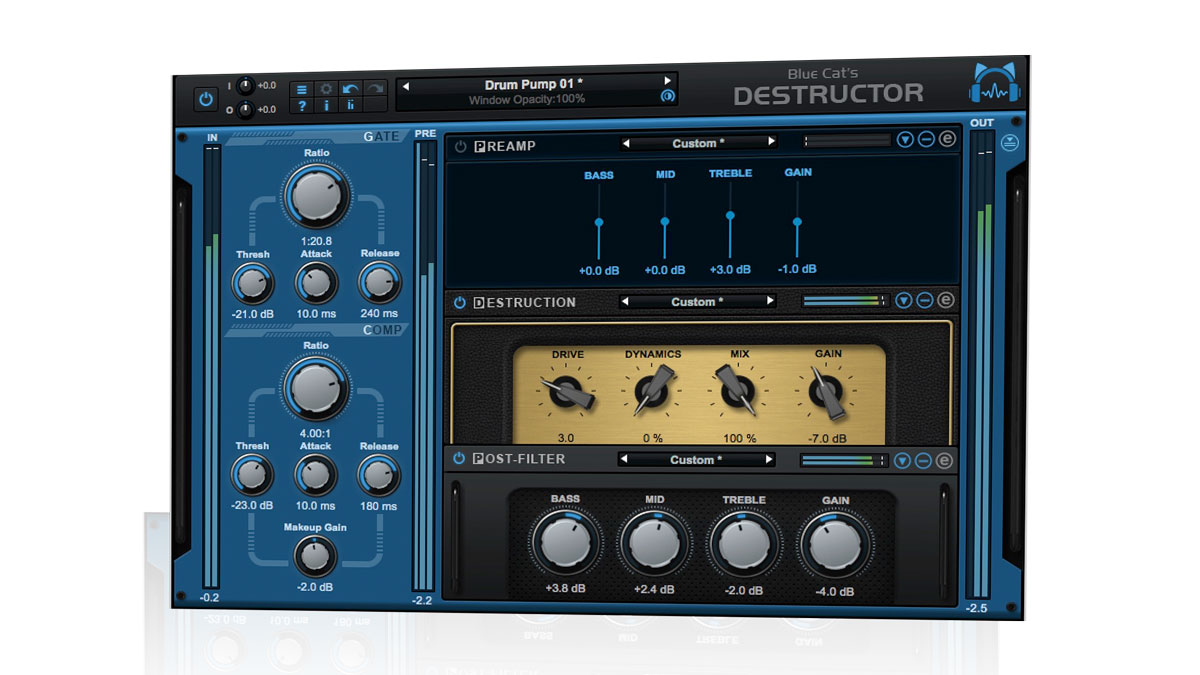MusicRadar Verdict
Guitarists will get right down with this authentic amp simulation, and electronic producers will find endless sound design potential behind its intuitive interface.
Pros
- +
Excellent-sounding distortion, saturation and decimation. Set and forget in Easy mode . Go deep in Edit mode. Cheap!
Cons
- -
Gate and compression settings in presets are arbitrary.
MusicRadar's got your back
To many producers who aren't also guitarists, amp sims can be a bit of a mystery - and that's a shame, because a good dose of distortion is often just the thing for bringing life and character to synths and drums as well as guitars and basses.
Blue Cat Audio's new virtual amp rig, Destructor (VST/AU/AAX/RTAS/DirectX), aims to make the process of dialling in distortion straightforward for those who just want to beef up their sounds with minimal user input. At the same time, it also gives the more technical engineer access to the guts of its virtual amplification and pre/post frequency- shaping stages, should they want it.
Appetite for destruction
The interface centres on a trio of modules: Preamp, Destruction and Post-Filter. Prior to all that, though, the input signal hits a gate and a compressor, for ironing out noise and peaks; while the end of the flow is topped off with a brickwall limiter.
The identical Preamp and Post-Filter modules represent the filtering effects of the valves, microphones and cabinets involved in real-world instrument amplification, boiling them all down to a pair of parametric EQs with (in Easy mode - see below) Bass, Mid, Treble, Tone and Gain controls.
Positioned in between those, the Destruction module is a waveshaper that dynamically scales its distortion in response to the input (or an external) signal. It offers Drive, Dynamics, Mix and Gain knobs (again, in Easy mode).
The idea is to shape the signal on the way in, focusing Destruction on particular areas, then sculpt it on the way out to reduce the volume of the emphasised frequencies and generally even out the sound.
The main, top-level presets (selected at the top of the plugin) - of which there are hundreds, divided up into multiple subcategories of guitar, bass and drums, plus other folders like Tape, Misc, etc - load all three modules with a combination of models and settings, for a wide range of saturation and distortion flavours, both analogue and digital. Each module then has its own presets (selected using the menu at the top of each module) - of which there are also hundreds.
Want all the hottest music and gear news, reviews, deals, features and more, direct to your inbox? Sign up here.
So, you can either load up a full preset and rock on, or choose your own preset for each module and tweak the controls to taste to create your own patches. That's not the end of the story, though, as clicking the 'e' button at the top right of a module switches it from the default Easy to Edit mode. Therein the detailed controls behind the reduced set on the front panels (which are macros, essentially) are revealed.
The Preamp and Post-Filter modules get graphically interactive parametric EQ. Drag the nodes left and right to adjust the centre/ corner frequencies of the bands (several of them not available from the front, including a comb filter), activate a background spectrum analyser or spectrogram, and load reference curves from Blue Cat's FreqAnalystMulti. Clicking the + button enlarges the display.
The edit mode controls for the Destruction module are even more involved. We don't have space to get into them fully here, but suffice to say that the shape, smoothness, symmetry, rectification, bit depth and dynamic response of the waveshaper curve are fully adjustable, as is the sample rate, anti-aliasing and more, all with readable visual feedback in the central display.
There's also a library of 1400 retro and modern skins and colour schemes onboard, selected per-module from a menu on each one. An impressively versatile, powerful plugin, Destructor is capable of everything from the hardest, filthiest of all-out decimation, through analogue-style distortion, saturation and 'lifting', down to subtle harmonic enhancement of clean tones.
It's bright, energetic and wholly convincing, and the dynamic waveshaping works really well, making it remarkably responsive and 'playable' - guitarists will simply love it.
In summary, Destructor is a revelation, bringing awesome distortion and tone shaping to your DAW at a great price.
Computer Music magazine is the world’s best selling publication dedicated solely to making great music with your Mac or PC computer. Each issue it brings its lucky readers the best in cutting-edge tutorials, need-to-know, expert software reviews and even all the tools you actually need to make great music today, courtesy of our legendary CM Plugin Suite.

